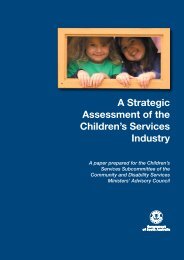Global Study On Child Poverty And Disparities (PDF) - Social Policy ...
Global Study On Child Poverty And Disparities (PDF) - Social Policy ...
Global Study On Child Poverty And Disparities (PDF) - Social Policy ...
Create successful ePaper yourself
Turn your PDF publications into a flip-book with our unique Google optimized e-Paper software.
Education trends are more positive, suggesting<br />
that a decline in the net enrolment ratio in primary<br />
school in the 1990s was reversed after 2000, and<br />
that there was an increase in the proportion of<br />
students reaching year eight. There also appear<br />
to have been large increases in the literacy rates<br />
of young adults. Gender equity trends are also<br />
positive, showing increases in the ratio of girls to<br />
boys in secondary and tertiary education.<br />
There also appear to be improvements in relation<br />
to child mortality, with the under-five mortality rate<br />
and the infant mortality rate each nearly halving<br />
since 1990, and with substantial increases in<br />
immunisation rates against measles. Maternal<br />
mortality trends also show an improvement, with<br />
the mortality ratio falling even if the number of<br />
maternal deaths increased. Both the proportion<br />
of births attended by skilled personnel and the<br />
contraceptive prevalence rate appear to have<br />
improved, and the teenage birth rate is falling.<br />
There also have been dramatic improvements<br />
in combating malaria, both in relation to its<br />
incidence and the associated death rate, as<br />
well as in the proportion of children sleeping<br />
under treated bed nets. Finally, there have been<br />
substantial improvements in the percentage of<br />
households using improved water sources, and<br />
even higher increases in the proportion using<br />
improved sanitation facilities.<br />
While many social outcomes have improved,<br />
it is clearly not possible to ascribe these<br />
improvements solely to the better economic<br />
performance over the past seven or eight years.<br />
In part this is due to limitations of the available<br />
data – for example, the lack of reliable trend<br />
data on household incomes and expenditures<br />
means that it is not possible to see whether the<br />
aggregate trends in national income have been<br />
mirrored in improvements in household incomes,<br />
particularly at lower income levels.<br />
Moreover, some improvements (for example,<br />
the increase in literacy rates of 15- to 24-yearolds<br />
and the improvements in infant and child<br />
mortality) were more rapid between 1990 and<br />
2000 than subsequently – that is, when rates<br />
of economic growth were lower. This suggests<br />
that policy changes could have been more<br />
influential in this earlier period. It is plausible that<br />
improvements in some of these indicators could<br />
be expected to slow down over time, and that<br />
achieving further improvements will become more<br />
challenging. Having said this, the fact that recent<br />
economic trends have been favourable and a<br />
wide range of social outcomes have improved<br />
over the same or longer periods is grounds<br />
for cautious optimism. Similarly, the fact that<br />
telecommunications reforms appear likely to have<br />
dramatically reduced information deprivation<br />
in a relatively short time demonstrates that<br />
policy reform can have a substantial impact on<br />
deprivation.<br />
Provincial disparities<br />
Preceding sections have made it clear that<br />
regional differences make a major contribution<br />
to disparities in child well-being in Vanuatu.<br />
Given the significance of location as a source<br />
of disparities, it is worthwhile bringing together<br />
as many dimensions of well-being as possible<br />
and summarising these findings. Table 4.2<br />
reviews the relative performance of different<br />
provinces. The ratio is calculated based on the<br />
Vanuatu national average Figure which is set at<br />
one. This allows us to understand how better or<br />
worse each province performs in relation to the<br />
national average. Provinces in which indicators<br />
are significantly worse than average (1.5 times<br />
the average or more) are shaded in red, average<br />
results (between 0.5 and 1.5 times the average)<br />
in blue, and better than average results (less<br />
than half the average) in green. All rankings are<br />
relative to the indicators chosen and give the<br />
same weight to each indicator (for example, the<br />
proportion of the child population below 50 per<br />
cent of median income is treated in the same way<br />
as the proportion who are severely underweight).<br />
Torba does significantly worse than the Vanuatu<br />
average in 11 of the 22 indicators, and Tafea<br />
does worse than average for nine indicators.<br />
Penama does worse than average in five<br />
indicators and Sanma in four, with no other<br />
province or location doing so poorly. However,<br />
Torba does better than average for three<br />
indicators, while Tafea does better than average<br />
in only one category.<br />
Malampa performs around the average or better<br />
in all categories, and overall appears to have the<br />
best outcomes for children. Shefa also performs<br />
relatively well in nearly all categories, except the<br />
proportion of children living below $1.25 a day.<br />
Luganville and Port Vila also perform better than<br />
average in many dimensions, but Luganville does<br />
very poorly in two categories (food and health)<br />
and Port Vila in three (regionally disaggregated<br />
poverty, food deprivation and severe stunting).<br />
71
















